Mount Circeo
Monte Circeo or Cape Circeo (Italian: Promontorio del Circeo [promonˈtɔːrjo del tʃirˈtʃɛːo], Latin: Mons Circeius) is a mountain remaining as a promontory that marks the southwestern limit of the former Pontine Marshes. Although a headland, it was not formed by coastal erosion – as headlands are usually formed – but is a remnant of the orogenic processes that created the Apennines. The entire coast of Lazio, on which the mountain and the marsh are located, was a chain of barrier islands that was formed on a horst and made part of the mainland by sedimentation of the intervening graben.
| Mount Circeo | |
|---|---|
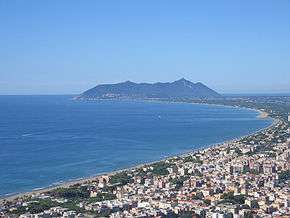 Mount Circeo as seen from Terracina, Italy | |
| Highest point | |
| Elevation | 541 m (1,775 ft) |
| Prominence | 541 m (1,775 ft) |
| Coordinates | 41°14′00″N 13°03′00″E |
| Geography | |
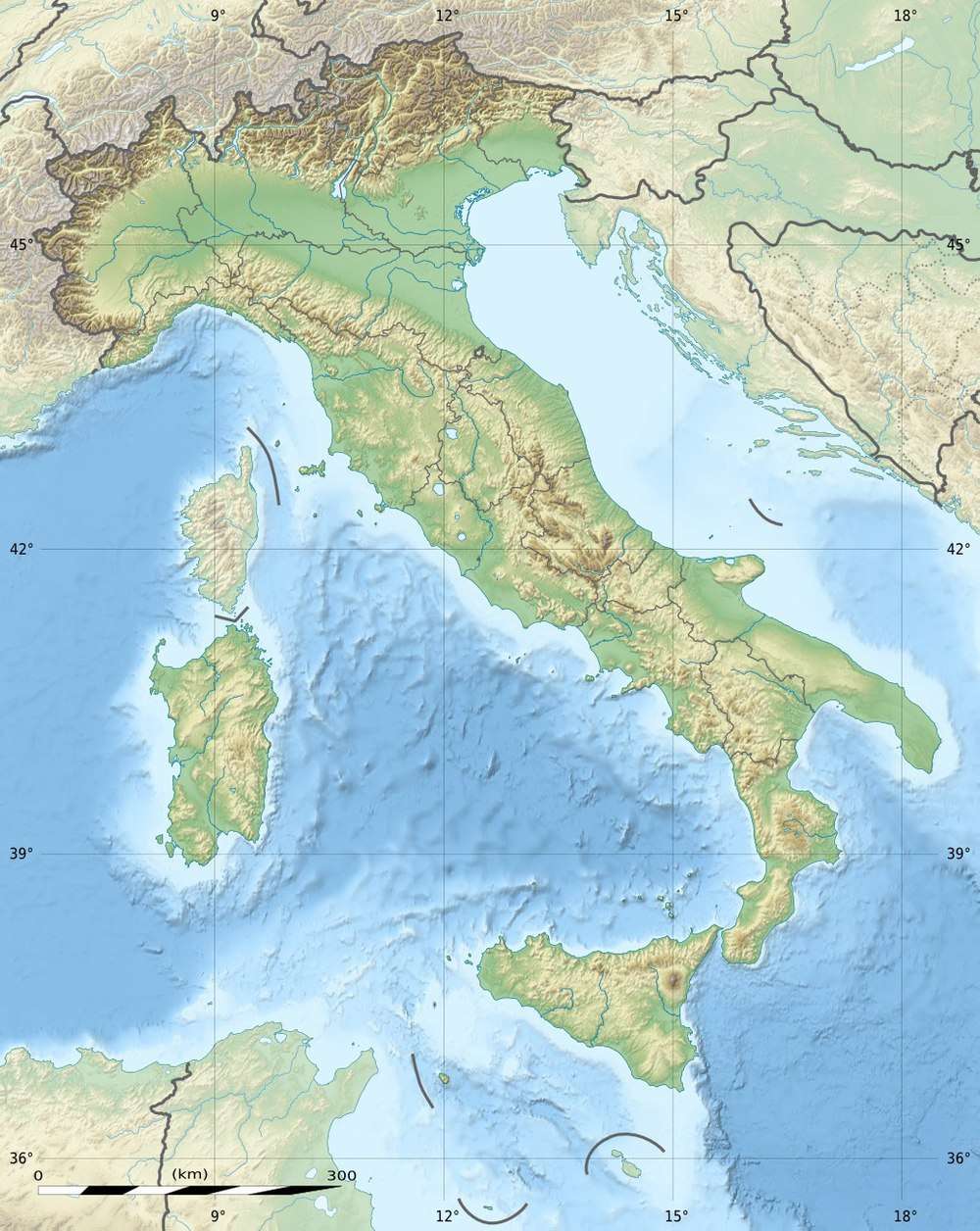 Mount Circeo Italy | |
| Location | San Felice Circeo, Lazio, Italy |
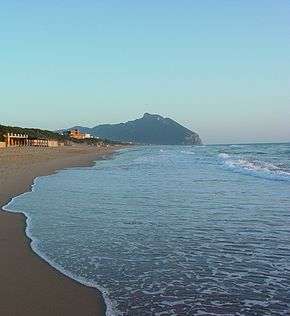
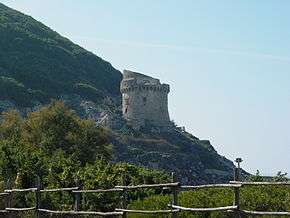
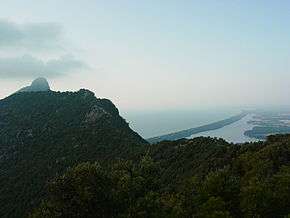
Monte Circeo, as it is sometimes also called in Italian, is located on the southwest coast of Italy, about 100 kilometres (62 mi) south-southeast of Rome, near San Felice Circeo, on the coast between Anzio and Terracina. At the northern end of the Gulf of Gaeta, it is about 5 kilometres (3.1 mi) long by 1.5 kilometres (0.93 mi) wide at the base, running from east to west and surrounded by the sea on all sides except the north. The land to the north of it is 15 metres (49 ft) above sea level, while the summit of the promontory is 541 metres (1,775 ft).[1] While the headland is quite steep and hilly, the land immediately to the east of it is low-lying and very swampy. Most of the ancient swamp has been reclaimed for agriculture and urban areas. The mountain, the coastal zone as far north as Latina, including the only remaining remnant of the swamp, and two of the Pontine Islands offshore, Zannone and Ponza, have been included in the Circeo National Park.
The mountain is composed mostly of marl and sandstone from the Paleogene and of limestone from the lower Early Jurassic.
Prehistory
In 1939, the skull of a Neanderthal man was found in the Guattari Cave by a team led by Alberto Carlo Blanc. Several other findings also show that the mountain was inhabited in prehistorical times.[2][3]
Ancient Roman times
The origin of the name is uncertain: it has naturally been connected with the legend of Circe, and Victor Bérard (in Les Phéniciens et l'Odyssée, ii. 261 seq.) maintains in support of the identification that Aiaia, the Greek and Georgian name for the island of Circe, is a faithful transliteration of a Semitic name, meaning "island of the hawk". The difficulty has been raised, especially by geologists, that the promontory ceased to be an island well before Homer's time; but Procopius remarked that the promontory has all the appearance of an island until one is actually upon it.[4][1]
Upon the east end of the promontory ridge are the remains of an enceinte, a polygonal structure that roughly forms a rectangle and that measures about 200 by 100 metres. The blocks are very carefully cut and jointed; right angles were intentionally avoided. The wall stands almost entirely free, as at Arpinum – polygonal walls in Italy typically form embanking walls – and increases considerably in thickness as it descends. The blocks of the inner face are much less carefully worked both here and at Arpinum. It seems to have been an acropolis, and contains no traces of buildings, except for a subterranean cistern, circular, with a beehive roof of converging blocks. The modern village of San Felice Circeo seems to occupy the site of the ancient town, the citadel of which stood on the mountain top; its medieval walls rest upon ancient walls of Cyclopean work of less careful construction than those of the citadel, and enclose an area that measures 200 by 150 metres (660 by 490 ft).[1]
Circeii, as it was then known, was founded as a Roman colony at an early date – according to some authorities in the time of Tarquinius Superbus,[5][1] – but also possibly about 390 BC. The existence of a previous population, however, is very likely indicated by the revolt of Circei in the middle of the 4th century BC,[6] so that it is doubtful whether the walls described are to be attributed to the Romans or the earlier Volscian inhabitants.[1]
The Roman colonists were expelled by the Volsci in around 490 BC during a war between those two states.[7] At the end of the republic, however, or at latest at the beginning of the imperial period, the city of Circei was no longer at the east end of the promontory, but on the east shores of the Lago di Paola (a lagoon – now a considerable fishery – separated from the sea by a line of sandhills and connected with it by a channel of Roman date: Strabo speaks of it as a small harbor) 1.5 kilometres (0.93 mi) north of the west end of the promontory. Here are the remains of a Roman town, belonging to the 1st and 2nd centuries, extending over an area of some 600 by 500 meters (2,000 by 1,600 ft), and consisting of fine buildings along the lagoons, including a large open piscina or basin, surrounded by a double portico, while farther inland are several very large and well-preserved water-reservoirs, supplied by an aqueduct of which traces may still be seen. An inscription speaks of an amphitheatre, of which no remains are visible. The transference of the city did not, however, mean the abandonment of the east end of the promontory, on which stand the remains of several very large villas. An inscription, indeed, cut in the rock near San Felice, speaks about this part of the Latin: promonturium Veneris ("promontory of Venus"; the only case of the use of this name) as belonging to the city of Circei. On the south and north sides of the promontory, there are comparatively few buildings while at the west end there is a sheer precipice to the sea.[1]
The town only acquired municipal rights after the Social War and was unimportant except as a seaside resort. Cicero compares its villas with those at Antium, and probably both Tiberius and Domitian resided there. Presumably, Domitian's villa contained important artistic works, such as the Apollo and the Faun With the Transverse Flute, and a spa. The view from the highest summit of the promontory (which is occupied by ruins of a platform attributed to a temple of Venus or Circe) is remarkably beautiful; the whole mountain is covered with fragrant shrubs. From any point in the Pontine Marshes or on the coast-line of Latium, the Circeian promontory dominates the landscape in the most remarkable way.[1]
Today
Mount Circeo is today included in the National Park of Circeo, established in 1934 on 5,616 ha (56.16 km2; 13,880 acres; 21.68 sq mi) over the territories of Latina, Sabaudia, San Felice Circeo and Zannone Island (minor island of Ponziane Archipelago).
References
-

- "Guattari Cave". NESPOS - Pleistocene People and Places. Retrieved 9 January 2020.
- "Guattari Cave - cranium". NESPOS - Pleistocene People and Places. Archived from the original on 9 January 2020. Retrieved 9 January 2020.
- .
- Livy, Ab urbe condita, 1.56
- Livy, Ab urbe condita, 6.12.6
- Livy, Ab urbe condita, 2.39